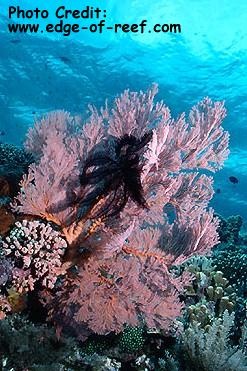
By Bob Goemans


Gorgonians are in the Class Anthozoa. Further division shows them in the Subclass Octocorallia, Order Alcyonacea (soft corals, stoloniferans, gorgonians) and finally found in the Suborders Calcaxonia, Holaxonia, and Scleraxonia. These suborders contain all sea whips, sea fans, sea rods, and sea blades. Most have a firm interior axial skeleton, usually a very pliable proteinaceous compound called Gorgonin or possibly a calcareous compound, which are then covered with tissue.
Those in this suborder are mostly non-photosynthetic species (azooxanthellae), frequently coming from the Indo-Pacific, (there are some Atlantic species) and usually found in deep water where they colonize walls of caves or are found on rocky and sandy bottom areas. Most require a temperature range between 73F to 81F (23 - 27C) along with good water movement and regular feedings of plankton-like foodstuffs. Few enter the trade and/or are suited for aquariums.
The Flamingo Tongue, Cyphoma gibbosum, a very pretty mollusk from the Caribbean, is fond of eating gorgonian tissue/polyps. Also, keep your gorgonin specimens out of the range of stinging corals, e.g., Bubble, Elegance, and Hammer corals.
Only a specimen that is attached to a piece of rock should be purchased. If the main stem is not attached to some form of substrate, the entire specimen could deteriorate rather rapidly. An epoxy putty can be use to anchor their base should it not already be attached to a piece of rock. Specimens that have blackened tissue or where the horny skeleton shows through should not be purchased.
Some gorgonian can possibly grow to the water's surface where they form ball-shape tips. Usually, they will branch-out under this bulbous tip and the aquarist can cut the branch, about two inches below, and secure the new stem elsewhere in the aquarium with underwater epoxy to form a new specimen.
Both photosynthetic and non-photosynthetic species consume plankton-like foodstuffs, e.g., rotifers, baby brine shrimp, and various commercially prepared plankton-like foods.